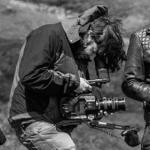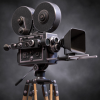Leaderboard
Popular Content
Showing content with the highest reputation on 11/29/2015 in all areas
-

Upgrading to an A7RII a mistake (Not a light read, Thoughts?)
iamoui and one other reacted to Andrew Reid for a topic
Well get a 7D then. Even cheaper. And crop will help telephoto reach for sports. Problem solved.2 points -
Rectilux Extreme Low Light Test (f/1.2)
Jim Chang and one other reacted to Brian Caldwell for a topic
Optics is mostly simple, with some occasional complexity thrown in to make it interesting. In fact, I've almost completely forgotten all the fancy math I learned after high school, since by and large all the math you need to know to be a successful lens designer is geometry, trigonometry, and a bit of algebra. In your case, assuming that the anamorphic portion is working at infinity (i.e., parallel light in and parallel light out) the aperture of the optical system is determined by the diameter of the iris diaphragm in the taking lens *unless* there is some other limiting aperture in the system. Imagine that you take a pin and poke a tiny hole in a large piece of aluminum foil. Next, open the f/1.2 taking lens wide open and place the aluminum foil in front of your Rectilux so that the pinhole is centered on the optical axis. Clearly, in this case the f/# of your lens system is determined by the diameter of the pinhole and not by the diameter of the taking lens' iris diaphragm. So we would say that the pinhole is the limiting aperture in your lens system. In your case the clear aperture of the back of the anamorphic section is 43mm in diameter (assuming it is round and not rectangular). This means that the collimated on-axis beam of light exiting your anamorphic section cannot exceed 43mm in diameter, and may be less if any of the other optical surfaces in the Rectilux or your anamorphic group are limiting apertures. The entrance pupil diameter of your 85mm f/1.2 taking lens (most likely 1/3 stop faster than f/1.4, or f/1.2599 in reality) is 85/1.2599 = 67.5mm. Since 67.5mm is bigger than 43mm you are underfilling the entrance pupil of the taking lens. As a consequence, you could stop down the taking lens until its entrance pupil is reduced to 43mm, and have no impact on the actual f/# of the system. In your case, the actual maximum f/# would be f/(85/43) = f/1.98 ~ f/2, and not f/1.2. Again, this assumes that the limiting aperture of the system is the rear aperture of the anamorph, and not some other surface in the Rectilux or the anamorph. If either of the latter is true then your true f/# would be slower than f/2.2 points -

Ursa Mini 4.6K new footage and info...
Volker Schmidt and one other reacted to Oliver Daniel for a topic
True story: new A7S user says: "I don't need to get any lighting gear now I have the A7S"... The world's best cinematographers will make a much better film with a smartphone than the average joe would with a Red Dragon and Cooke primes. Now with the accessible price of the URSA Mini, there will be volumes of negative comments blaming the camera for poorer than expected quality.2 points -
So, this came up in another thread I was just in, and I see it mentioned here and there on the forum, but I think it deserves its own topic so I'm starting one. I recently became very interested in recording externally to an Atomos or similar from my Sony bodies in an attempt to break the 30min limit. Seemed like a no brainer, especially with the current ridiculous falling price of Ninja units. But before I jump in, I wanted to read up on the workflow so I'd know what to prepare for. Until now, I was unaware of what the Skin Smoothing setting in the camera did (honestly, what self respecting photog or videog would have that enabled in the first place anyway), but now I'm suddenly VERY aware of it. Apparently (and I'm just going by what I see online in my research), there is some sort of bug in the firmware of many of the BIONZ X based cameras, that turns this blasted smoothing feature on when recording video even if you disabled it in the menu. If you aren't aware of this bug, this guy's video pretty much nails it in demonstration: https://www.youtube.com/watch?v=E6GVm1Ke2dQ Since I didn't hear many people being scared off by this, I figured you can't go by one guy on the internet's opinion of a perceived problem. But then I found it again mentioned in Phillip Bloom's blog regarding using the A7S with a Shogun here: http://philipbloom.net/blog/dad/ (about half way down the page) And here it is again by Dave Dugdale: http://www.learningvideo.com/atomos-shogun-review/ (third paragraph) Then some guy in a forum shared this video to demonstrate how well the atomos was working with his A5100: https://youtu.be/-DmrpLji6gk He apparently wasn't even aware of the waxy skin thing going on with her face, but I see it right away now that i'm aware of it! It seems that this issue is a legit one. While I've read that a firmware update to the RX series has solved it on that camera, the rest of us trying to record off our A6000, A5100, A7S, etc have this blasted thing show up whenever a face can be recognized. The "solution" has been to turn off face recognition and press record in camera. Without recording in camera, the hdmi out defaults to smoothing on again. I'm wondering, how many people do this and just haven't noticed it happens? Now that I've seen it and will be looking for it, I'm afraid it will drive me bonkers. OR do people just hit record in the camera to disable it? My real question is, what about those of us who want to do this simply because we want to record longer durations than the internal recording allows? What happens when my A7S reaches 30 min and stops recording internally? Does everyone's face suddenly go all waxy? And what about trying to use external recording to prevent overheating on the smaller A5100? Hitting record on the camera isn't an option because it will build up heat too fast to even make it to 30 minutes most of the time. Is there another solution I'm not aware of?1 point
-

EOSHD Gear Sale
Jimmy reacted to Andrew Reid for a topic
1 point -
Just ran a short series of clips with the Leica M Mono Type 246 ..... Crushed in PP with an Alexa SL profile but it maintains the sense of the scene ... Sorry no dialog nor plot ... sounds like a reflection of my life. Password is daysend. https://vimeo.com/147254517 Gone at the end of the day. Bob1 point
-

Upgrading to an A7RII a mistake (Not a light read, Thoughts?)
exomonkeyman reacted to Nikkor for a topic
But the difference between a 60D (he owns one) and a 7D is very small.1 point -
Upgrading to an A7RII a mistake (Not a light read, Thoughts?)
exomonkeyman reacted to ntblowz for a topic
You shoot with PP off, that will fix the clipping I personally spend more money on lens and support gears than camera body, since camera body depreciate too fast and support gear will work with what ever camera you have. Lens doesn't depreciate too fast like body do.1 point -
Upgrading to an A7RII a mistake (Not a light read, Thoughts?)
exomonkeyman reacted to BrorSvensson for a topic
The commlite af with a7rii is way way inferior to the af with metabones v4 adapter. Its amazing how much difference the adapter makes. I'd also add in that i shoot 50% video 50% stills with my a7 and use manual focus primes for everything, i have a beautiful set of fast nikkor ai's.1 point -

Blackmagic Micro Cinema Camera
Zak Forsman reacted to AaronChicago for a topic
It is a good price, but I don't think it's necessarily the right match for the BMMCC. No LUT support, limited scopes, mid-quality screen. The BMMCC records internally so you don't need external recording. I personally have become used to monitoring LOG or FILM modes with a LUT. To each his own though.1 point -

Upgrading to an A7RII a mistake (Not a light read, Thoughts?)
exomonkeyman reacted to Nikkor for a topic
But the 5dmkii only if it's not real sports because the AF is kind of lame.1 point -
Hi, I'm new to this forum and posted the questions below to the "Lenses" topic already, but should have posted them here (Admins - sorry about that!). Here are the questions: Andrew's great review has got me convinced that I need this camera because I love slo mo! I'd love to try the hack mentioned in that article about increasing the camera's poor zoom range. Would anyone be able to recommend a teleconversion lens to use with this camera? Or is it just pot luck? Based on reviews at bhphotovideos.com, I can see that some lenses won't even focus properly! Also, these teleconversion lenses only work when the RX100 is already at its full telephoto zoom range, right? What happens in between the max range then? No focus? Thanks in advance! K.1 point
-

Upgrading to an A7RII a mistake (Not a light read, Thoughts?)
exomonkeyman reacted to Andrew Reid for a topic
Instead of spending so much more on Sony's lenses, it might be an idea to keep a little pet 5D Mark II body for AF with Canon glass, and let your A7R II do all the video and manual focus stuff (+ low light). They are cheap used now... under 800 quid!1 point -
Upgrading to an A7RII a mistake (Not a light read, Thoughts?)
exomonkeyman reacted to Jpr for a topic
I use the cheaper Sony/zeiss lenses like 55 1.8 when I want AF and then use all manual Contax zeiss . Cheaper and amazing quality. For £1000 I have 55 1.8 zony, cy 28 2.0, cy 85 2.8, cy 100-300 f4-5.6. Stunning glass that works on my nx1 too (when not using 16-50s).1 point -

Upgrading to an A7RII a mistake (Not a light read, Thoughts?)
exomonkeyman reacted to Nikkor for a topic
Buy manual glass, and yes you can have cheap and good quality. I have a d800 and the tyical af lenses ,135 2,28 1.4, 85 1.4, 70-200 2.8,etc... But since I got manual lenses, I mostly leave the AF stuff at home, it's big and clumsy, and my eye sight is good enouh to focus by eye. The a7rII is even better for is, you have an evf, and you have access to all lens mounts, minolta, fd,etc... Sell that ugly zoom (you can adapt your canon zoom) and spend those 600pounds on a complete manual setup. (Thats what I would do) i don't understand the part where you say your photography has taken a hit, if I understand correctly you were using the canon 60d before, with no special lenses.1 point -

Upgrading to an A7RII a mistake (Not a light read, Thoughts?)
exomonkeyman reacted to Andrew Reid for a topic
Have you not heard of the Metabones adapter for you Canon lenses? Yes AF and lenses are one area for Sony to work further on. And yes the FE lenses are too costly. Agree with you there! I am using mostly Canon glass and manual focus rather than AF. With Canon lenses on A7 bodies, AF can sometimes be very fast especially on the A7R II but the hit rate is poor compared to the FE lenses. The Zeiss ZA lenses via EA-LA4 adapter solve this but then another big expensive investment. For stills compare the handling of the Olympus E-M5 II or Fujifilm X-T1 to the Sony bodies and you will see where they have got it badly wrong1 point -
Lens-yclopedia RELOADED
Tito Ferradans reacted to valery akos for a topic
1 point -
Haha yea... After the long holy grail search for the cinematic look, we are finally reaching the moment people will go "ahh, it was good lighting all along".1 point
-
"Seen these - but what exactly are these cheap chinese helicoid things? I guess to mount the lens, because the Diaplan is a projector lens indeed". Helicoid is the focusing ring and supplies a rear mount to adapt to camera. I've converted many projector lenses this way, cheap way to achieve results similar or identical with projector lenses vs the much more expensive photographic versions. 99% of the time the projector lenses have no aperture, but if it's all about the bokeh and shallow DOF...it is not always a downside. Helios 40-2 is a great lens, but if you wanted soap bubble bokeh as close as possible to your example image, The Meyer Diaplan 100mm f/2.8 or Pentacon AV 100mm f/2.8 projector lens would probably be as close as you would get - sub 100 quid. If aperture-less lenses don't scare you too much, a 'cheaper' alternative to the Helios 40-2 is the Cyclop H3T-1 version. Was made to fit soviet night intensifier scopes. I have one remounted to an M65 Helicoid and it is one of my favourite lenses by far. Crazy bokeh with oval aperture installed to give faux anamorphic look, fixed oval aperture shape effectively stops the lens down slightly on horizontal axis to improve sharpness and eliminate colour fringing that is present wide open on this model, and the regular Helios 40-2. Oh man, I'm currently on the lookout for Orestor 100mm f2.8 (15 blade zebra version) - can you recommend it as good taking lens for morphic? What the flares/ coating like...decent for complimenting iscomorphot/Kowa B&H golden flare? Already own the 135mm, which is lovely, but a bit too long for morphic rigging sometimes.1 point
-
Having lived through the PC/MAC years I don't remember it as a slam-dunk. Keep in mind that Gates did the same thing with IBM. Hindsight for all this is 20/20. I see the opposite with modern cameras. What they've been able to achieve in the past 10 years is nothing short of astounding to me. When I get into film in 1970s, the technology had been more or less the same for 40 years, the high end being 16mm and low-end 8mm. Think about that, if the tech we were using today was petty much the same as what we were using in 1975! Yet, I have a Panasonic LX100 in my bag that shoots as well as, if not better, than the quarter-million dollar cameras in "Phantom Menace" 15 years ago. Better WiFi would be nice, but keep in mind that an app can't access the password to the wireless network and the only real solution is to build a second transmitter and that's not up to the camera companies (it's up to the smartphone makers). That it works at all, given the constraints, is to be applauded. The number one problem all cameras make is light sensitivity (as it was in film). Software can only do so much. Anyway, there is a rich ecosystem of camera software out there, though not from the camera makers. Building cameras and building software are two different skill-sets, IMHO. The biggest problem today is people don't spend the time to experiment and learn how to use the technology they have. Most people put whatever gadget they have on "auto." There needs to be more respect, love, and FUN with THE ART OF PHOTOGRAPHY/FILM. This blog does a great job at that, except when it looks at the glass as half-full and gets into arm-chair business discussions that are better left to the nit-wit junior financial analysts down in The City1 point





